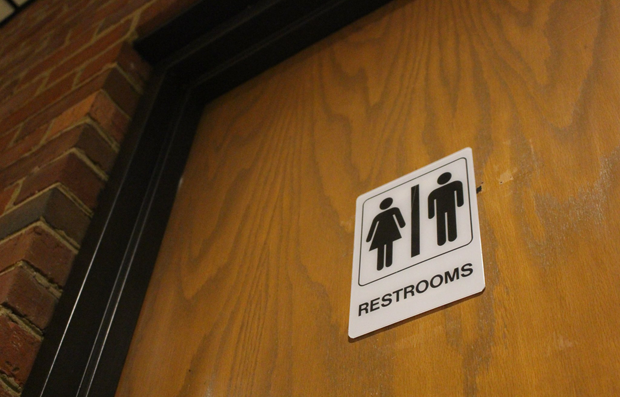
(Photo: Georden West)
A women’s university considered to be one of the most restrictive on transgender issues in the US is reconsidering its approach.
Rated as the strictest of any US university on transgender policies by the Chronicle of Higher Education, Hollins University currently forbids students from making any legal or biological step toward becoming male.
But a university official says the school is considering the addition of gender-neutral bathrooms to make the campus more welcoming and to support its students on the transgender spectrum.
Founded in 1842, Hollins University has attracted many now famous names including writers Annie Dillard and Margaret Wise Brown, US Poet Laureate Natasha Trethewey and White House correspondent Ann Compton.
However, in the past few years its restrictive policy on the retention of transgender students has attracted national attention from activists and academics.
The current policy states that any student who “’self identifies’ as a male and initiates any of the following processes: 1) begins hormone therapy with the intent to transform from female to male, 2) undergoes any surgical process (procedure) to transform from female to male or 3) changes her name legally with the intent of identifying herself as a man,” will not be allowed to graduate from the university. After substantial criticism, Hollins agreed to re-evaluate its policy and drafted a new version in 2013. The current policy also maintains the university’s position against allowing female-to-male students and adds that any student who chooses to undergo sex reassignment “will be helped [by university officials] to transfer to another institution.”
The issue of gender-neutral spaces has become increasingly contentious and polarising with the emergence of a new transgender-equality group on campus called EqualiT*. Its appearance was marked by mysterious flyers in bathroom stalls and on announcement boards calling for the addition of gender-neutral bathrooms. Soon a blog and a Facebook page also appeared, and the group began to stage events, including a candlelight vigil to commemorate Transgender Awareness Day. Due to the sensitive nature of the organisation, the group has remained mainly anonymous in hopes of protecting its transgender members. Some students fear that, if exposed, transgender students will lose their scholarships or be expelled from the university. The university has not taken any action against students who are legally and biologically female, but some students say they self-censor because they are worried about what may happen.
With a student population of less than 600, low retention rates and a high-priced tuition cost of over $46,000 per year, critics question whether the university can afford to alienate any portion of its student demographic.
The forced removal of transgender students from Hollins presents not only financial and academic challenges but a threat to students’ safety. Forty-five per cent of transgender university students in the US reported experiencing verbal, physical or sexual abuse due to their gender identity according to a 2011 study by the National Center for Transgender Equality. Many transgender students attending all-female institutions regard the environment as safe and welcoming and fear for their safety in transferring to a coeducational environment. A study in 2006 revealed that one in twelve transgender people is murdered in the United States, and many more experience severe verbal harassment and physical violence.
“I believe creating gender neutral safe spaces should be at the forefront of the actions Hollins is taking right now,” said Cal Thompson, a transgender student who graduated in the spring of 2014. “Everyone needs a safe space for personal business. We don’t want to use the gendered bathrooms just as badly as the cisgendered don’t want us.”
Despite the relative safety transgender students feel at Hollins, students still find the university a challenging place to explore individual gender identities. Perhaps one of the most substantial of these challenges is in the lack of gender-neutral spaces, specifically bathrooms. Because of the requirement for students to remain female during their time at Hollins, students who identify as transgender are prohibited from using the men’s restroom.
“Using the bathroom at Hollins was uncomfortable,” said Lee Collie, a 2013 graduate, known as Leanna during his time at Hollins. “Even if you flip the sign to ‘male’ when you walk in, girls walked in all the time and said, ‘Oh, it’s just Lee,’ which meant that they didn’t really see me as a male.”
Hollins’ Dean of Students, Patty O’Toole told Index, “As we continue to renovate our facilities, when appropriate we are considering developing gender-neutral bathrooms.” With regards to facilities in residence halls, students in each community can collectively determine facility-usage and associated language, O’Toole said. Bathroom usage in residence halls is indicated by a paper sign for each hall’s bathroom, which can be flipped over to indicate different users. Thus, some facilities may be labelled with “men” and “women,” while others may use “residents” and “guests.” No other official steps have been taken to utilise gender-neutral language.
A number of students disagree with the student organisation’s position, including current student Deborah Birch, class of 2016. “I don’t think that there should gender-neutral bathrooms on campus. You apply to Hollins knowing that it is an all-women’s institution. If want to change your biological make-up to transition from female to male, you should choose to attend another institution.”
Though transgender graduate Lee Collie likes the idea of gender-neutral restrooms, he also worries about respecting the larger campus community, specifically those with opposing ideals. “I would probably limit them to the dorms or specific floors, because we have professors and visitors who may not feel comfortable.”
Hollins is not the only US institution struggling over whether it should create gender-neutral bathrooms. Recently Illinois State University has attracted media attention through its decision to change its family bathroom to an all-gender bathroom. Although the change was not specifically requested by any students or faculty, ISU officials made the change in efforts to remain proactive and to promote inclusivity among all members of campus. Over 150 universities across the United States have instituted similar changes in campus facilities, including New York University, Ohio State University and UCLA. Even fellow women’s universities like Smith College in Massachusetts and Agnes Scott College in Georgia have begun to embrace the issue, with the addition of gender-neutral restrooms and more progressive policies.
Collie, a former vice president of the university’s student government association, stated that the policy at Hollins may be strict, but he is glad that Hollins has a policy and acknowledges the existence of transgender students on campus. Other women’s universities have yet to adopt any policy on the matter.
Dean of Students, Patty O’Toole explained that the 2011 policy was originally created by the university’s Board of Trustees in response to students on the transgender spectrum who were seeking a written policy. “Hollins wanted to support those students. The focus of the policy is not strictness but clarifying our institutional mission.”
Collie supported the university’s actions and its mission as a women’s institution, despite the personal challenges he faced, and related the support and camaraderie he experienced at the university. “Hollins has never punished me for being or identifying as male. It isn’t that they’re trying to stop someone from being who they really are, but it is Hollins standing true to itself as well.”
This article was published on August 6, 2014 at indexoncensorship.org




